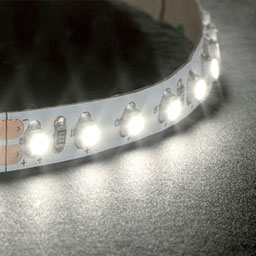Create a Light Show
Millumin allows you to configure and control an entire light show, and synchronise it within your video show.
This tutorial will show you the different aspect needed to do so.
Create a Light
To get access to the light tool, switch to the light mode at the top right corner of the workspace :
![]()
In this mode, the workspace is replaced by a light plot. Now, when you try to create a layer with the "+" button at the bottom left, or with CMD+l, it adds a light to the light plot :
Connect your light
After creating your first light in Millumin, you have to link it to your real light. Lights are controlled via the DMX protocol. You can read this
page to know all the compatible devices you can connect to Millumin to send DMX.
First, you need to tell your light at which device it is connected. In the properties panel, look at the gear of DMX Channel. Here, you can select the device :
![]()
If you doesn't find your device, click on the "manage devices..." button. Here, you'll be able to create a new device. So in the end, you'll can connect your light to it :
Then, when your light is connected to its device, don't forget to check if it is connected to the good DMX channel :
![]()
Configure your light
You can now configure what kind of light you want to use. By default we create "theatrical" light : a light with only an intensity parameter. This kind of light is ideal to control standard lights like a PAR 16.
For a better readability of your light plot, you can change the mode of your light :
By default, Millumin also handle RGB and RGBW PAR :
When you use those fixtures, you'll be able to control each of the channel Red, Green, Blue or White.
Adding custom light
If you don't find the fixture you looking for, you can download it
here.
Or click here :
![]()
On the Open-Fixture-Library you'll be able to search the right fixture for you light and download it.
Or directly download all the fixtures via the button in Millumin. Or on Open-Fixture-Library website :
![]()
You also can
create and edit your own fixture if you cannot find it :
![]()
Once you have download your new fixtures, you have to add them to Millumin :
Then, relaunch Millumin to see them in the fixture popup :
Manipulating your light
Lights are managed like any other layer. So you can create
interactions or
animations.
If you need a quick overview of all your light, open the DMX panel :
Here, you can have an overview of all your light, send them DMX order, or make them blink to find them on stage.
In this panel you can find a matrix view of all your light and simply monitor them :
The "Lights" tab offer you a quick way to change the settings of your light :
- rename it
- change it device
- edit it channel
Lights and timeline
The timeline is a very useful tool when you want to manipulate your lights. It allows you to create animation loops for your lights, and recall them at many time in your dashboard. Please read
this tutorial to know more about how Millumin handles animations.
When you work on animations, you don't want to manipulate all your lights but just the one you want to animate. So when you create a timeline, you'll don't see any light in the timeline :
You'll have to select them and manually add them :
Now you can manipulate your light in your timeline and create some beautiful animations !
Setting up your light plot
Now let's take a closer look at the light plot. The main idea of this tool is to spatially manage your lights.
You can insert a plan of your stage by drag and dropping it :
And place your lights on it, in line with the reality of your show.
Tips : you can directly change the intensity of your lights in the light plot, by scrolling with your mouse :

 Millumin Help
Millumin Help








































